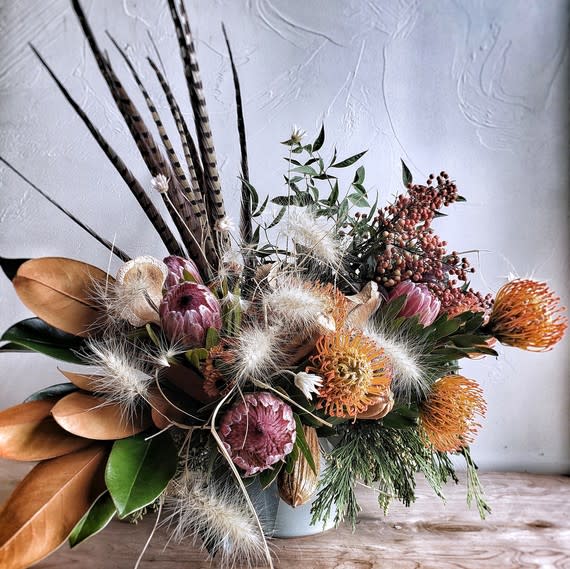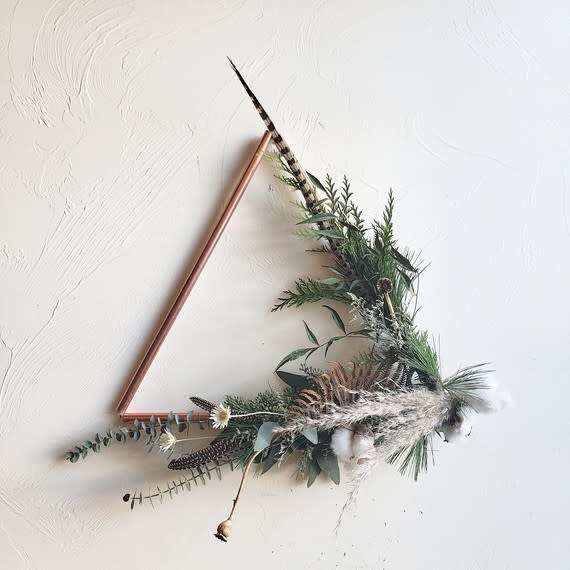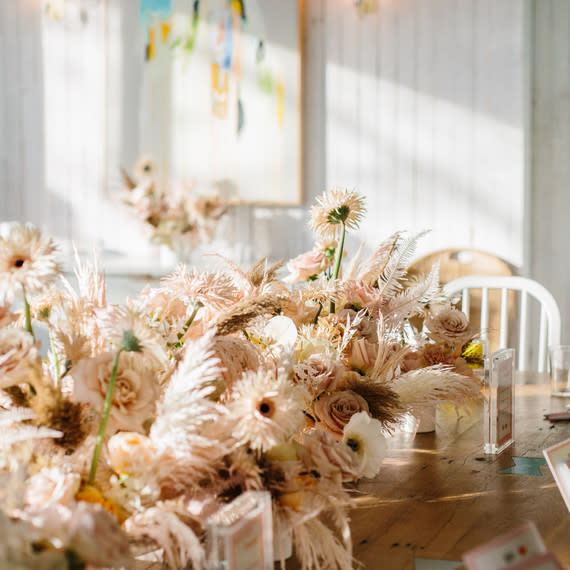Why Florists Are Loving Dried Flowers Right Now

If there's anyone who knows a thing or two about flower trends, it's Chris DeMeo, wholesale florist at N.Y.C.'s Dutch Flower Line. He's privy to what all of the city's top florists, stylist, and event designers are buying and has been in the business for more than 20 years. In other words, he's seen it all (or, quite a lot). Right now, he says, dried flowers are having a moment. "It all started because people are going for colors that feel a bit antiqued with a patina to them, and there are only so many [fresh] flowers in that palette. So, people became more and more creative and started using dried elements—to give their arrangements that vintage vibe," says DeMeo.
He also attributes their popularity to social media. "Before, [a new trend] wouldn't take off until it was published in a magazine. Now, everything spreads like wildfire. So if something starts trending, it blows up," he explains. Which might explain why florists across the country are using them. Ask any florist and Instagram will likely not come up as their impetus for incorporating preserved elements into their designs. Rather, it's the versatility and longevity of dried blooms that gives them appeal. "[They] introduce a completely new universe of textures, dimensions, shapes and color palettes than their fresh counterparts," says Kelsea Gaynor, founder and creative director at East Olivia, a New York City-based creative agency. "The biggest benefit is that they last forever," offers Sierra Steifman, owner of New York City-based floral design studio Poppies & Posies. "They're a great way to add florals to your home and not have to worry about changing them out often." This week, coincidentally, she's doing a large installation in a client's home using only dried flowers.
Related: The Best Flowers to Plant for a Beautiful Cutting Garden
They can also have an ethereal quality to them, as Remy Brault, owner of Bozeman, Montana-based flower boutique Labellum relays: "My favorite part is that they are so light and airy. When you pass by or a slight breeze comes through a window, it will make little pieces flutter. And, they have a shelf life for potentially years—if you can carefully remove any dust."

While some florists are purists (Steifman prefers grouping dried flowers together as she did with the curated bundles she made for lifestyle boutique AtLand during the winter holidays), others enjoy the contrast that comes from mixing fresh and dried together. "That way, when most of the fresh elements have come to end, there are pieces within the arrangement that someone can pull out and save. It's always nice to have a dried sprig to place in a fun bud vase," suggests Brault.
A unanimous favorite vehicle for dried goods: the wreath. "They're wonderful in wreaths because you can create a really gorgeous design that doesn't have to feel 'holiday,'" says Steifman, who enjoys working with dried strawflower, hydrangea, lavender, thistle and various types of pods and pampas grasses. Other preserved favorites include roses, statice, bleached ferns, hops, and palm fronds.

Brault works with such an extensive lineup of preserved elements that she breaks them down into categories: grasses, pods, flowers, herbs, and naturals (ie: moss, cotton and tumbleweed). Gaynor, on the other hand, has experimented with dying and painting her dried goods. "We custom dye almost all of our pampas grass," says Gaynor, who also shares a disclaimer: "With dried goods, you are dealing with ingredients that typically have less give—they are more static/fragile—and they can be quite a challenge to work with. It's a challenge I personally really enjoy, though!"
To any skeptics out there for whom dried flowers conjure images of grandma's house or a bygone era of shabby chic, let Steifman change your perception: "Dried flowers are experiencing a come back right now—especially among a younger, trendier set. They're no longer 'country chic.'" They're so novel, in fact, that when luxury French beauty brand Buly 1803 opened their Marais outpost in 2017, they carved out a space in the shop dedicated solely to preserved blooms. "Clients definitely appreciate the art of dried flowers because they're out of the ordinary—what they want is something new and different," says Buly 1803 co-founder Victoire de Taillac. Though, DeMeo would counter that, "it's not the flower itself [that's extraordinary], it's how you use it."

How to Make Your Own Dried Blooms
Want to try drying your own? Here's a step-by-step guide, including tips from our experts. Start by stripping any excess foliage from flowers and cut stems to your desired length. Then, hang them in a dark, dry area (like a closet or pantry). They can be hung individually or bundled together, but be sure not to overcrowd any groupings and to avoid sunlight in order to help them retain their color. If you are in a more humid location, try hanging a paper bag over the flowers while they dry—it will absorb moisture released from the flowers during the drying process and will help keep dust off of the blooms. Let them hang undisturbed for two to three weeks or until completely dry. Most flowers will be completely dry within a month. And always dry more than what you need, as a few might not make it.
(function(d, s, id) { if (d.getElementById(id)) return; var js = d.createElement(s); js.id = id; js.src = '//cdn4.wibbitz.com/static.js'; d.getElementsByTagName('body')[0].appendChild(js); }(document, 'script', 'wibbitz-static-embed'));

